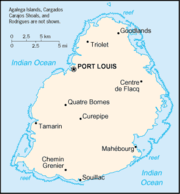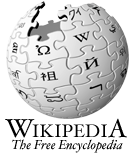
Geography of Mauritius
Background Information
SOS Children produced this website for schools as well as this video website about Africa. Sponsor a child to make a real difference.
| Native name: Maurice Nickname: The Star and Key of the Indian Ocean |
|
|---|---|
 Map of Mauritius |
|
 |
|
| Geography | |
| Location | Indian Ocean |
| Coordinates | 20°17′S 57°33′E |
| Archipelago | Mascarene Islands |
| Area | 2,030 square kilometres (780 sq mi) |
| Highest elevation | 828 m (2,717 ft) |
| Highest point | Piton de la Petite Rivière Noire |
| Country | |
|
Mauritius
|
|
| Largest city | Port Louis (pop. 147,688) |
| Demographics | |
| Population | 1,264,866 (as of 2007) |
| Density | 616 |
| Ethnic groups | Indo-Mauritian 68%, Mauritian Creole people 27%, Sino-Mauritian 3%, Franco-Mauritian 2% |
Climate
The local climate is tropical, modified by southeast trade winds; there is a warm, dry winter from May to November and a hot, wet, and humid summer from November to May. Anti-cyclones affect the country during May to September. Cyclones affect the country during November-April. Hollanda (1994) and Dina (2002) were the worst two last cyclones to have affected the island.
Statistics
Location: Southern Africa, island in the Indian Ocean, east of Madagascar
Geographic coordinates: 20°17′S 57°33′E
Map references: World
Area (includes Agalega Islands, Cargados Carajos Shoals (Saint Brandon), and Rodrigues):
total: 2,040 km²
land: 2,030 km²
water: 10 km²
Area - comparative: almost 11 times the size of Washington, D.C.
Land boundaries: 0 km
Coastline: 177 km
Maritime claims:
continental shelf: 200 nmi (370.4 km; 230.2 mi) or to the edge of the continental margin
exclusive economic zone: 200 nmi (370.4 km; 230.2 mi)
territorial sea: 12 nmi (22.2 km; 13.8 mi)
Terrain: small coastal plain rising to discontinuous mountains encircling central plateau
Elevation extremes:
lowest point: Indian Ocean 0 m
highest point: Piton de la Petite Rivière Noire 828 m
Natural resources: arable land, fish
Land use:
arable land: 49.26%
permanent crops: 2.96%
permanent pastures: 3%
forests and woodland: 22%
other: 23% (1993 est.)
Irrigated land: 200 km² (1998 est.)
Natural hazards: cyclones (November to April); almost completely surrounded by reefs that may pose maritime hazards
Environment - current issues: water pollution, degradation of coral reefs
Environment - international agreements:
party to: Biodiversity, Climate Change, Climate Change-Kyoto Protocol, Desertification, Endangered Species, Environmental Modification, Hazardous Wastes, Law of the Sea, Marine Life Conservation, Nuclear Test Ban, Ozone Layer Protection, Ship Pollution, Wetlands
signed, but not ratified: none of the selected agreements
Geography - note: The main island, from which the country derives its name, is of volcanic origin and is almost entirely surrounded by coral reefs
